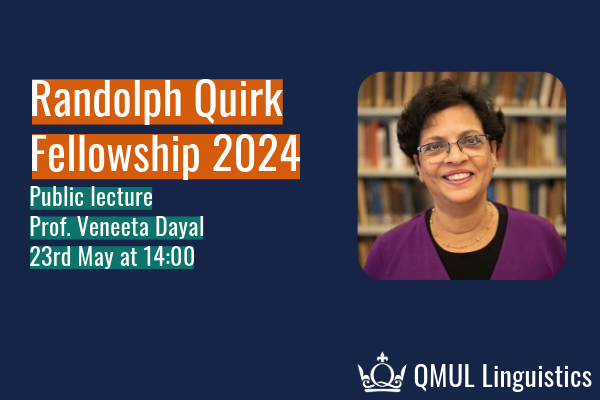Randolph Quirk Fellow Public Lecture: Professor Veneeta Dayal
When: Thursday, May 23, 2024, 2:00 PM - 4:30 PM
Where: Maths Building: Lecture Theatre and online, Mile End campus

Lecture title: Optional Plural Marking in General Number Systems and the Effects of Animacy Restrictions
Click below to download the lecture slides:
RQF 2024 Public Lecture Slides [PDF 1,366KB]
We are delighted to be welcoming Professor Veneeta Dayal (Yale University) to Queen Mary University of London as our Randolph Quirk Fellow for 2024. Join us on the week of 20th May 2024 for a series of three workshops with Professor Dayal on consecutive days, culminating in the Randolph Quirk Fellow Public Lecture on 23rd May at 14:00.
Veneeta Dayal’s research focuses on the semantics of natural language, and its interface with syntax and pragmatics, typically from a cross-linguistic perspective. Veneeta completed her PhD at Cornell University in 1991. From 1990 to 2019 she was a faculty member in Linguistics and a Distinguished Professor at Rutgers University. Presently, she is Dorothy R. Diebold Professor of Linguistics at Yale university.
Optional Plural Marking in General Number Systems and the Effects of Animacy Restrictions
Languages in which the unmarked form allows for plural reference are often argued to have optional plural markers: Mandarin -men, Japanese -tachi, Korean -tul, Bangla -gulo, Cuzco Quechua kuna, Indonesian reduplication, to name a few. This talk will focus on the following two properties that are often associated with such items: (i) they convey strict plurality, unlike the unmarked form, which is compatible with singular reference and (ii) they are often restricted to human/animate nouns, never (all markers that take inanimate nouns, also take human/animate nouns).
In this talk I present an account of the Cuzco Quechua marker -kuna, described as an “optional” plural marker by Faller (2007). I argue, based on joint work with Liliana Sanchez and Janett Vengoa, that -kuna is not a plural marker at all. It is better characterized as a sorting mechanism that presupposes that the noun it takes as its complement allows for proper partition along some dimension (type, shape, color etc), we dub this the sortability presupposition. This is shown to be the source of the strict plurality that has been observed for N-kuna – only a plurality with multiple individual parts can satisfy the sortability presupposition.
While -kuna can combine with human/animate as well as inanimate nouns, its semantic impact differs across these two domains. Human-denoting unmarked nouns only allow for singular reference in episodic statements, while inanimate unmarked nouns allow for singular as well as plural reference. We show that this effect can be derived from the analysis of -kuna as encoding a sortability presupposition, interacting with our perception of human beings as inherently sortable, as an instance of Maximize Presupposition! Inanimate nouns, on the other hand, allow for a plurality with undifferentiated parts which are not subject to Maximize Presupposition!
I will try to connect insights about the Cuzco Quechua “optional” plural marker -kuna with what we know about strict plurality and animacy restrictions in other languages for which such items have been posited. In doing so, I will try to determine the extent to which animacy restrictions have relevance. I will also draw on the animate/inanimate distinction with reference to sortability criteria from elsewhere in the grammar, most notably in the choice of D-linked vs. non D-linked wh expressions.